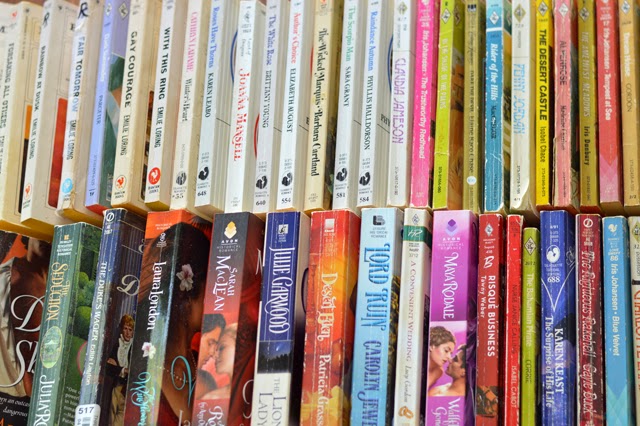The TBR Challenge this month was a “Recommended Read” and E from Bookpushers had been steadily insisting that I read Nalini Singh for…oh…roughly forever? I’d purchased a used paperback copy of Angels’ Blood a while ago, but I have a tendency not to read paperbacks now that I have a Kindle. I mostly read in bed after the lights go out so having a book with its own built-in light source has quickly spoiled me.
Am I ever glad I picked up this one for the TBR Challenge though. I haven’t read a lot of paranormal romance and the little I have read hasn’t always worked well for me. This is a gross generalization, but a combination of world-building pickiness, a difficulty finding balance between romance and paranormal plots, and a tendency in some paranormals to over-subscribe to traditional gender roles (or maybe worse, insist than the heroine is So Very Strong, but still have the hero save her at every opportunity) biased me against them. Laura Kaye is one author that bucked that trend for me. I really enjoyed her Hearts of the Anemoi series (more fantasy than paranormal, but which tends toward the same subgenre issues). Delilah Dawson’s Blud series was another that worked well. And I really loved Angels’ Blood. So it’s probable that I’ve been super unjust in my perceptions–judging an entire category of books by the vampire romances I’ve tried and failed to like over the years.
Angels’ Blood does have vampires, but there were a couple crucial differences from the vampires I’m familiar with. These ancient vampires actually behave like I expect ancient vampires to behave. They’re not perpetual emotional teenagers hellbent on sex and destiny. They have different thoughts and motivations and sense of time than a mortal. They can actually get a little bit bored with being unable to die. They’ve experienced lots of loss. They’re not just paler, sexier, more dangerous humans. They are recognizably “other”. The same can be said of the angels who rule them.
Speaking of which, vampires in this universe are created by and are subservient to angels. And the Cadre of Ten are archangels, the most powerful beings in the universe Singh has created. Raphael, the hero of Angels’ Blood, is one of these archangels. And while this book doesn’t have much in common with Christian mythology, the conception of angels is exactly like the Biblical one. When angels deign to acknowledge mortals, mortals cower and quake in fear. Raphael should be and is terrifying, just for the sheer amount of power and influence that he wields. But this hero isn’t the most powerful being in his universe even though he’s quite a bit more powerful than the heroine. The overarching plot is that of a rogue archangel who the hero and heroine team up to find, one who has tasted blood that has made him both more powerful and more unstable.
Elena, the heroine, is a hunter of rogue vampires who have escaped their angels before the term of their service contract is up. And while she can’t quite match Raphael, she has a different kind of power, one that is gradually revealed over the course of the novel. She may not be able to blow up buildings with a flick of a finger, but her strength of will and her mortality allow her to exercise a control over the hero that he finds both alluring and terrifying. Plus, in a nod to Loretta Chase’s classic historical romance Lord of Scoundrels, she shoots him. He needed shooting. But it isn’t just the gun that causes damage. It’s primarily the fact that his attraction to Elena has made him just the slightest bit mortal and therefore vulnerable. Not weak. He’s never weak. But then, neither is she.
There are skills she has that he doesn’t, mainly her ability as a hunter to scent vampires, one that now works on the rogue archangel. The two of them track him through his reign of terror over the streets of New York in a dramatic, gruesome, detective plot that also serves to heighten the romantic and dramatic tension between them. Seriously, the tension. Like the best detective buddy romances though, I thought the build-up was better than the sexual pay-off. I’ll be curious to see if the sex holds more power in subsequent novels. Instead it felt almost but not quite like a Moonlighting scenario where I wanted them to stay apart for as long as possible. Their romantic friction was the best part of the romantic arc. That said, the denouement was terrific. On the off chance that folks haven’t read it, I don’t want to spoil the ending (though in fairness, I saw it coming from a fair distance).
What fascinated me most about Angels’ Blood was the way the novel played with the power differentials between all the characters. I’m not sure I came to any strong conclusions about the nature of angeldom, humanity, femininity or masculinity as a result of the novel, but it sure did open up a lot of questions about how much control any of us (regardless of power) can be expected to be able to exert over our own environments. If I’m interpreting it correctly, nearly every character is forced to abandon themselves to a greater power at some point in the narrative, a real struggle when each of them is accustomed to ruling over whatever they consider their domain.
In a genre that seems ever more concerned with ensuring that each character is strong and independent–giving over both heroes and heroines to unreasoning stubbornness and unendingly arbitrary clashes of will–Angels’ Blood was a breath of fresh, rain-scented air.
I’m very much looking forward to reading more by Singh, including her new rockstar series, which has been getting rave reviews.
And I’m very, very glad that my TBR yielded up a really satisfying read after last month’s Anne Weale debacle. I’m totally in love with the TBR Challenge and can’t wait for next month. The theme is “Series Catch-Up” so I’m going to pull out The Two Gentlemen of Altona, the first of Lisa Henry and J.A. Rock’s Playing the Fool series. It’s only been on my TBR for a few months, but I keep hearing lovely things about the second book so I’m eager to start in on it.
What have you been reading lately?


